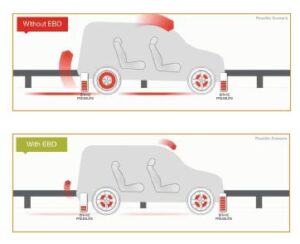Electronic Brake-force Distribution
No data was found
You’re driving at a safe speed on a moderately busy highway. It has not been snowing for long, but already the pavement is dusted with snow and becoming slippery. Suddenly, another motorist signals to enter your lane and makes a sharp veering motion. You are forced to hit the brakes to avoid hitting the encroaching vehicle. The weight of your car is thrust forward from the heavy braking, putting added pressure on the front wheels to stop the car. Meanwhile, the sudden shift in weight has significantly reduced the amount of traction available for the back wheels. After a few seconds, the back wheels lock completely. You feel the back end of your car start to fishtail into the lanes on either side of you. Finally, the back-and-forth motion of the rear of the car overcomes the braking power of the front wheels and you spin around, face-to-face with oncoming traffic. Situations like this are potentially very dangerous. Electronic brake-force distribution is a vehicle safety feature that can prevent this kind of event.
What is electronic brake-force distribution (EBFD)?
EBFD is an active vehicle safety feature designed to make braking as efficient as possible. A special function of antilock braking systems (ABS), EBFD makes the amount of brake force applied to a wheel proportional to that wheel’s load at the time. Just like how hitting the brakes hard moves your body forward, heavy braking pushes the weight of your vehicle forward onto its front wheels. When this happens, the rear wheels may not have enough weight on them to grip the road. This can cause the rear wheels to begin to spin and eventually lock up. Locked wheels are generally very dangerous because once your wheels lock you lose all steering power. Locked-up back wheels not only increases your risk of fishtailing, but it also forces the front wheels to do all the work with only half of the total braking force available (because the other half of your brake force is still being applied – uselessly – to the locked rear wheels). This can result in longer stopping distances, wheels spinning, and possibly loss of control.
EBFD reduces these dangers by automatically balancing the brake force applied to each wheel according to the overall weight distribution of the vehicle. When your EBFD system senses that one or more of your wheels is at risk of locking, it will reduce the brake force applied to the affected wheel(s), and, if necessary, apply more brake force to wheels that are not at risk of locking. Electronic brake-force distribution is also sometimes also called electronic brake distribution (EBD), or dynamic rear proportioning (DRP).
EBFD is similar in many ways to antilock braking systems (ABS), and the two are usually installed together. ABS helps to prevent wheels from locking by sensing the threat of wheel lockage and then releasing and apply the brakes in rapid succession. The difference between EBFD and ABS is that EBFD actually changes the amount of brake-force being applied to any given wheel according to the likelihood of that wheel locking. The added benefit of being able to redistribute brake-force makes EBFD a particularly useful extension of standard ABS setups.
When would EBFD be useful?
While driving it may seem like all four wheels are working in the same way. However, this is often not the case. Road conditions, weather conditions, and weight within the vehicle can all result in the vehicle’s weight being unevenly distributed across its four wheels. This can affect how each wheel is working individually. EBFD would be useful in the following scenarios:
- While braking, one wheel goes over a pothole in the road, destabilizing the vehicle and making braking less efficient.
- One of your wheels is on ice, making it more likely that it will lock and cause your car to spin out.
- A moose runs onto the road and you need to brake and swerve quickly.
- Another motorist does not notice you when making a lane change, and you are forced to brake hard.
Since EBFD works together with ABS, it is useful in every situation where ABS is useful. These situations include those listed above, and generally cover any time a driver has to hit the brakes to avoid a collision.
How does EBFD work?
Electronic brake-force distribution is always installed with antilock braking systems (ABS). ABS installations that are supplemented with EBFD react more quickly and deliver more situation-specific braking commands than older ABS setups.
EBFD systems are usually made up of three subcomponents which are monitored and guided by an electronic control unit (ECU). These components includes speed sensors for each wheel (sensors that monitor how fast the wheel is rotating), brake-force modulators (a mechanism that increases or decreases brake-force applied to a wheel), an acceleration /deceleration sensor that detects the vehicle’s forward and sideways acceleration/deceleration, and usually a yaw sensor (a sensor that monitors a vehicle’s movement along its vertical axis). The electronic control unit interprets the information from the speed and yaw sensors and then sends commands to the brake-force modulators. Similar to how ABS setups operate, the ECU in EBFD systems is attached to the hydraulic brake-force modulator. So, while the ECU and brake modulator serve different purposes, they are physically combined into one electro-hydraulic unit.
EBFD works by monitoring each wheel’s responsiveness to the brake, and then tailoring the amount of brake-force applied to each wheel. In vehicles without EBFD, when you apply the brakes the brake-force is evenly distributed across all four wheels. The danger here is that if, for example, one of your wheels is on ice and locks up, you lose 25% of your braking power. On a vehicle with EBFD, the system would sense that one of the wheels is not braking properly, and would redistribute the brake-force to the unaffected wheels to obtain optimal braking power. This way, you retain the maximum amount of braking power possible and reduce the risk of fishtailing or spinning around.
The yaw sensor installed with most EBFD systems also helps prevent oversteering and understeering. Oversteering occurs when a vehicle continues to turn beyond the steering input of the driver, while understeering refers to cases where the vehicle does not turn enough in response to driver commands. Both oversteering and understeering are the result of insufficient traction on the road. If you begin to oversteer or understeer, the yaw sensor will record unusual movement along the vehicle’s vertical axis, and your EBFD system will react by applying either the brakes on the inner wheel (to correct understeering) or the brakes on the outer wheel (to correct oversteering).
Is EBFD effective?
Along with providing the foundation for the integration of other stability control and braking systems, electronic brake-force distribution promises the following benefits:
- Heavy braking is more comfortable: since braking is more effective with EBFD, your vehicle stops faster, which mitigates the effects of heavy braking on the human body (i.e., throwing your body forward towards the steering column).
- Enhanced overall vehicle safety: EBFD helps reduce your risk of fishtailing, spinning, oversteering, and understeering. Since braking is more effective on vehicles with EBFD, you will likely notice a reduction in stopping distance.
- Improved braking predictability: the way your vehicle brakes constantly changes depending on the condition of the road, the total weight of the vehicle, and the distribution of weight within the vehicle. By automatically adjusting brake-force to its optimal distribution, EBFD can help reduce the effects of these factors and make braking more predictable and effective.
There is little data speaking to the effectiveness of EBFD alone since it is often packaged with other vehicle safety systems, notably ABS. However, the similarities in design and function between EBFD and ABS suggest two things:
- First, the kinds of driving scenarios that ABS addresses can be assisted by EBFD;
- second, the effectiveness of EBFD can be expected to at least match the effectiveness of ABS.
Vehicles equipped with standard ABS setups (i.e., without EBFD) show a reduced stopping distance in low-traction conditions and a significantly lower risk of being involved in frontal collisions (Farmer et al., 1997). Since EBFD makes braking as efficient as possible, it likely helps reduce stopping distance in slippery conditions. Optimal braking efficiency should also help further reduce the incidence of frontal collisions.
Standard ABS systems have not been shown to lower a driver’s risk of being involved in a fatal collision (IIHS, 2011). Experts have suggested this is because drivers tend to exaggerate their steering commands in emergency situations which can result in a loss of control of their vehicle and serious crashes (Farmer et al., 1997; Williams and Wells, 1994). However, the yaw sensor included in most EBFD systems can help mitigate the risk of losing control, making swerving to avoid potential hazards safer.
EBFD is likely to be most useful on front-engine vehicles, sport utility vehicles (SUVs), and heavily loaded vehicles. Front-engine vehicles are more likely to experience rear-wheel braking inefficiency during heavy braking because of the extra weight at the front of the vehicle. EBFD compensates for the weight differences across the vehicle. SUVs are taller than regular vehicles and therefore have a higher centre of gravity, making them inherently more unstable and prone to a driver losing control. The yaw sensor in EBFD helps correct any potentially dangerous side-to-side motion. Finally, if you are driving a vehicle that is heavily loaded or unevenly loaded, EBFD will sense the position and amount of extra weight and adjust brake-force accordingly. It is important to remember, however, that EBFD is designed to be helpful in all types of vehicles, and you do not need to be driving a front-engine vehicle, SUV, or heavily loaded car to feel the benefits of EBFD.
In summary, while the benefits of EBFD alone have not been tested, pairing EBFD with ABS is likely to not only enhance the existing benefits of antilock braking systems, but also to help decrease the likelihood of becoming involved in a dangerous situation as a result of heavy braking and swerving around an obstacle.
Does any limitations with EBFD?
Yes. As with most vehicle safety systems, realizing the benefits of EBFD depends on whether drivers understand its design limits and primary function, and can interact appropriately with it.
The goal of EBFD is to give you optimal braking efficiency by distributing the brake-force proportionally to the braking power of each wheel. EBFD cannot warn you of impending collisions or bad road conditions, so it is up to you to assess road conditions and notice any potential hazards.
In addition, EBFD is only useful at speeds under a certain threshold. The faster you drive, the longer it will take to stop safely. Beyond a certain speed, you may not be able to combine EBFD braking power with safe steering input. Excessive speed can seriously limit the benefit of EBFD and, in worst-case scenarios, make it impossible to stabilize your vehicle in an emergency.
The effectiveness of EBFD is dependent to a large extent on the decisions the driver makes in the moments right before, during, and right after a period of heavy braking.
- Speeding, driving while fatigued, driving with distractions, tailgating other drivers, and driving in bad weather can all negatively impact the benefits from EBFD because these behaviours impair your ability to drive safely. Deciding to consume alcohol before driving, for example, slows your reaction time and makes it more difficult to react in emergency situations.
- During heavy braking you must not pump the brake. While this technique was taught previously as a method to prevent wheels from locking, modern ABS/EBFD systems work by pumping the brake automatically for you. If you need to hit the brakes in a car with EBFD, the best thing to do is to apply firm and constant pressure to the brake pedal.
- Right after braking, you must also be ready to steer safely and decisively away from danger. Some research on drivers’ experiences with ABS suggests that panicked steering after heavy braking can lead drivers into more trouble (Farmer et al., 1997; Williams and Wells, 1994). In a vehicle without ABS where the wheels have locked, an extreme steering command would have no effect since the driver does not have directional control. However, since ABS prevents wheel lock, an equipped vehicle would respond to the driver’s exaggerated steering input, which may lead to an increased risk of losing control, rolling over, or running off the road. It is crucial that while your ABS/EBFD system is working to stop your vehicle, you are working to steer it towards safety. Any of the previously mentioned unsafe driving behaviours can seriously undermine your ability to steer safely in emergency situations.
Making good decisions before, during, and right after heavy braking requires combining your understanding of how best to apply safety features with safe driving habits. While EBFD will never warn you of impending danger, as long as you are capable of recognizing hazards and reacting appropriately to them EBFD will enhance your overall security on the road.
How can I get the most out of my EBFD system?
Getting the most benefit from your EBFD system requires that your vehicle be well-maintained. For instance, if your EBFD system shifts brake-force to the front wheels during a hard stop but the treads on your front tires are worn down, you will not see optimal results from the system. The tires and brakes on the vehicle with EBFD need to be serviced regularly so that your emergency braking systems can work at their best.
EBFD can help make braking on poor road conditions as safe as possible, but this does not mean that it’s completely safe. There are still many dangers associated with driving in bad weather conditions, including low visibility and less overall traction. Whether or not EBFD helps also depends on how quickly you react to a potential hazard and how safely you can steer to avoid it. Given both of these limiting factors, you are always encouraged to use vehicle safety features like EBFD to complement your responsible driving practices, and not as a reason for driving less attentively or less cautiously.
Is EBFD useful in all situations/ can I turn it off?
Most EBFD systems can be disabled by either manually disconnecting a fuse or depressurizing the brakes from within the vehicle. Your owner’s manual should have instructions on how to disable this feature, if disabling it is possible. That being said, you should be aware of two important considerations before choosing to disengage EBFD:
- First, since it is unlikely that EBFD will ever make a situation less safe, there is virtually no advantage to be gained from turning it off.
- Second, since most EBFD systems are paired with ABS you should never disable one without disabling the other. This is important since ABS setups that include EBFD anticipate the activation of EBFD when it is necessary. If EBFD is disabled while ABS is left on, you may experience decreased braking power.
Disabling vehicle safety features is generally discouraged, and drivers are always encouraged to use their judgment when deciding to disable any safety feature. If you choose to disable a feature, it is important that you are aware of any effect that this will have on how to drive safely. This is especially true with ABS systems – including ABS systems that incorporate EBFD – since the proper way to brake changes depending on whether the system is active.
How prevalent is EBFD in today’s vehicles?
Electronic brake-force distribution began being installed with ABS systems in the mid-2000s. Most modern ABS systems now include EBFD as a standard or optional add-on. In the model year 2010, 89% of cars and 99% of new light trucks had ABS installed; however there are is no data on how many of these ABS systems included EBFD. Transport Canada does not require that ABS be installed on vehicles (Transport Canada, 2012), so the best way to find out whether your vehicle has EBFD is to consult your owner’s manual.
How much does EBFD cost?
EBFD is a standard part of modern ABS setups. Therefore, equipping a vehicle with EBFD costs the same as installing ABS: approximately $240.00 in the factory. In addition, installing EBFD on a vehicle has virtually no impact on overall fuel efficiency.
Visit brainonboard.ca/program-resources/references for a full list of references.
Related Videos
Play Video


